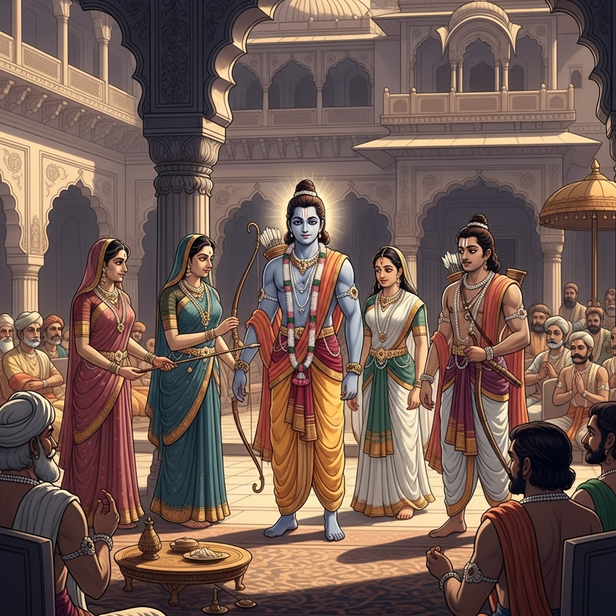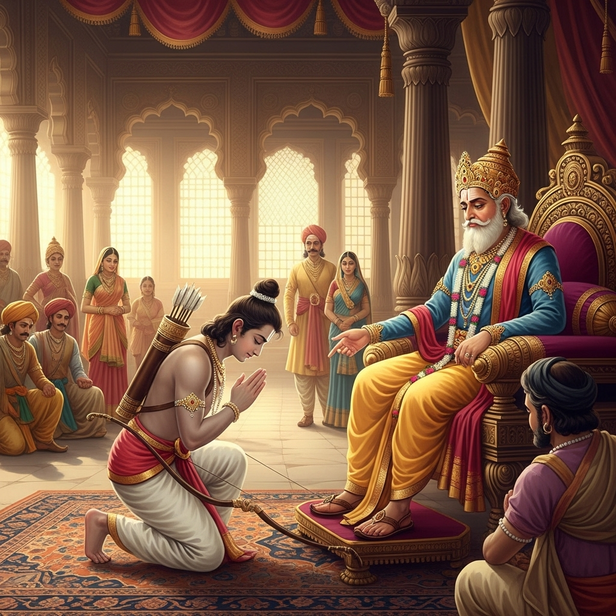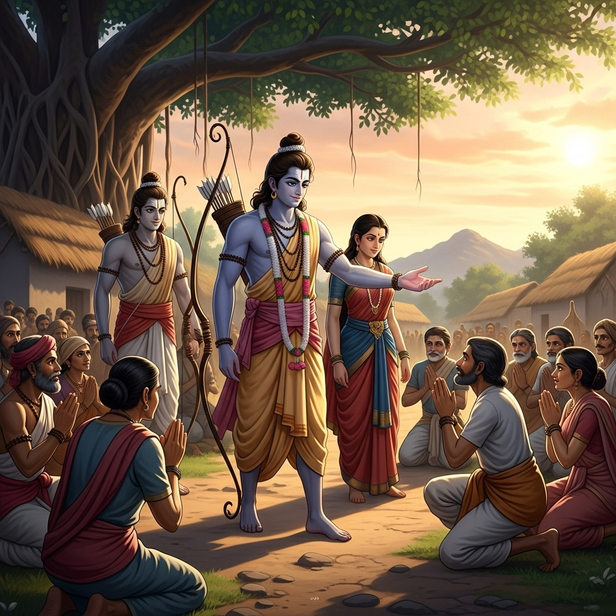Why Rama Chose Exile Instead of Fighting Back
Noopur Kumari | Sep 12, 2025, 08:00 IST
Rama
( Image credit : Times Life Bureau )
When Kaikeyi demanded Rama’s exile, he had every reason to protest. He was the rightful heir, loved by the people, and blessed with strength to fight back. Yet, Rama smiled, bowed to his father, and accepted exile without anger. Why did the greatest prince of Ayodhya embrace hardship instead of resisting? This story is more than history it is a lesson in patience, duty, and the power of surrender. Through Rama’s choice, we learn why true strength is not in conquest but in sacrifice.
When injustice touches us, our first instinct is to fight back. We feel wronged, and anger rises like fire. But Lord Rama, when stripped of his throne and sent into exile, chose silence over resistance. He could have raised his bow, he could have refused, yet he didn’t. His decision still leaves us questioning: Why did Rama accept exile with grace instead of claiming his right? The answer lies deep in dharma, patience, and the strength of the soul.

Rama’s choice to accept exile was not weakness but wisdom. He knew that dharma the eternal law of truth and duty, stood above his personal desires. Though the throne was rightfully his, he saw kingship not as power to enjoy but as a sacred responsibility to protect harmony. If he resisted, Ayodhya would fall into chaos; by obeying, he preserved its peace. His decision shows that true strength lies not in clinging to what we deserve, but in sacrificing for the greater good. Rama’s exile reminds us that real victory comes from upholding values, even at the cost of personal loss.

Dasharatha’s anguish was unbearable when Kaikeyi demanded Rama’s exile, but Rama’s response was pure devotion. For him, his father’s word carried more weight than his own rightful throne. He could have resisted, yet he chose silence and sacrifice, turning pain into honor for his father. Rama teaches us that true love is not always about claiming what we deserve it is about preserving the dignity of those we cherish. In our own lives, there are moments when quiet obedience, guided by faith, becomes an act of strength, not weakness. Through surrender, Rama revealed the deepest form of devotion.

Exile was never punishment it was Rama’s conscious sacrifice. He understood that true greatness lies not in claiming power, but in upholding righteousness. By leaving the throne, he preserved dharma and became immortal in the hearts of people. The crown might have marked him as a king, but walking barefoot in the forest made him divine. Life often teaches us that surrendering for truth leaves a legacy far greater than any victory won through force. Rama’s exile reminds us that letting go for the sake of principle can transform ordinary actions into timeless lessons of courage and integrity.

Exile for Rama was more than losing a throne; it was a journey through hardship harsh forests, hunger, and separation from loved ones. Yet, he faced every challenge with unwavering patience and inner strength. Walking barefoot and enduring discomfort, his spirit remained unbroken, turning suffering into wisdom. Similarly, in our lives, we face our own “exiles” times when circumstances feel unfair or overwhelming. Rama teaches us that patience is not idle waiting but continuing forward with faith, courage, and acceptance, even when the path is difficult. True strength grows not from comfort but from enduring life’s trials.

Rama’s choice was not just about Ayodhya it was about humanity. If he had fought back, his story would have been forgotten as a power struggle. But by embracing exile, he became the eternal symbol of dharma. His journey in the forest shaped him into the Rama who would later defeat Ravana and restore cosmic balance. His exile teaches us that life’s trials prepare us for greater victories, and sometimes, surrender is the highest form of strength.
Rama’s decision to accept exile was not defeat but a profound act of wisdom. He teaches that silence can hold greater power than rebellion, that sacrifice can leave a more lasting impact than victory, and that patience can turn suffering into growth. In life, when confronted with injustice, we often struggle between resistance and surrender. Rama’s example shows that true strength lies in surrendering to truth, not from fear, but from inner courage. By letting go of ego and embracing duty, we align with a higher purpose, discovering that surrender can lead to enduring peace and ultimate triumph.
Explore the latest trends and tips in Health & Fitness, Spiritual, Travel, Life Hacks, Trending, Fashion & Beauty, and Relationships at Times Life!
1. Dharma Above Desire

Lord Rama
( Image credit : Times Life Bureau )
Rama’s choice to accept exile was not weakness but wisdom. He knew that dharma the eternal law of truth and duty, stood above his personal desires. Though the throne was rightfully his, he saw kingship not as power to enjoy but as a sacred responsibility to protect harmony. If he resisted, Ayodhya would fall into chaos; by obeying, he preserved its peace. His decision shows that true strength lies not in clinging to what we deserve, but in sacrificing for the greater good. Rama’s exile reminds us that real victory comes from upholding values, even at the cost of personal loss.
2. A Son’s Obedience

Rama bowing to Dasharatha
( Image credit : Times Life Bureau )
Dasharatha’s anguish was unbearable when Kaikeyi demanded Rama’s exile, but Rama’s response was pure devotion. For him, his father’s word carried more weight than his own rightful throne. He could have resisted, yet he chose silence and sacrifice, turning pain into honor for his father. Rama teaches us that true love is not always about claiming what we deserve it is about preserving the dignity of those we cherish. In our own lives, there are moments when quiet obedience, guided by faith, becomes an act of strength, not weakness. Through surrender, Rama revealed the deepest form of devotion.
3. Strength in Sacrifice

Rama walking into exile forest
( Image credit : Times Life Bureau )
Exile was never punishment it was Rama’s conscious sacrifice. He understood that true greatness lies not in claiming power, but in upholding righteousness. By leaving the throne, he preserved dharma and became immortal in the hearts of people. The crown might have marked him as a king, but walking barefoot in the forest made him divine. Life often teaches us that surrendering for truth leaves a legacy far greater than any victory won through force. Rama’s exile reminds us that letting go for the sake of principle can transform ordinary actions into timeless lessons of courage and integrity.
4. The Power of Patience

Rama, Sita, and Lakshmana in the forest
( Image credit : Times Life Bureau )
Exile for Rama was more than losing a throne; it was a journey through hardship harsh forests, hunger, and separation from loved ones. Yet, he faced every challenge with unwavering patience and inner strength. Walking barefoot and enduring discomfort, his spirit remained unbroken, turning suffering into wisdom. Similarly, in our lives, we face our own “exiles” times when circumstances feel unfair or overwhelming. Rama teaches us that patience is not idle waiting but continuing forward with faith, courage, and acceptance, even when the path is difficult. True strength grows not from comfort but from enduring life’s trials.
5. A Lesson for Humanity

Rama blessing villagers during exile
( Image credit : Times Life Bureau )
Rama’s choice was not just about Ayodhya it was about humanity. If he had fought back, his story would have been forgotten as a power struggle. But by embracing exile, he became the eternal symbol of dharma. His journey in the forest shaped him into the Rama who would later defeat Ravana and restore cosmic balance. His exile teaches us that life’s trials prepare us for greater victories, and sometimes, surrender is the highest form of strength.
A Lesson in Dharma and Sacrifice
Explore the latest trends and tips in Health & Fitness, Spiritual, Travel, Life Hacks, Trending, Fashion & Beauty, and Relationships at Times Life!
